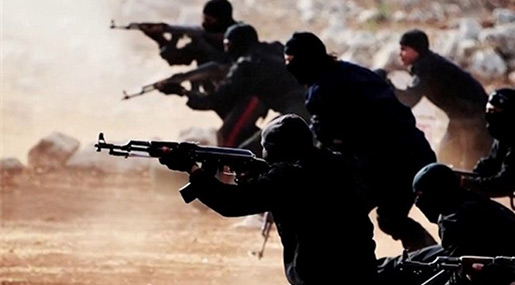Exclusive: Dismantling the Life Cycle of the Violent Takfiri Groups

Hosam Matar
Weeks ago, elements from al-Nusra Front - the Syrian branch of al-Qaeda - launched an attack on the town of al-Zara in central Syria. Al-Nusra slaughtered a group of men in front of their families before taking the women and children hostage. Similar incidents have been sweeping the Middle East and North Africa region on a daily basis. Where did this shocking phenomenon come from? Is it Islamic culture, marginalization, or Western Conspiracy?

Understanding this phenomenon and its mechanisms require that we understand its life cycle or its cycle of elevation. No single variable can provide a convincing explanation of this phenomenon, and it would also be pointless to explain it through every variable (culture - marginalization - geopolitical competition) without understanding the role and significance of each variable and where it comes to play in the emergence of these movements. I argue that the framework through which to understand the life cycle of these groups is made up of three main phases: "Birth Phase" (Cultural Roots), The fermentation and maturation phase (Socio-politik), and the emergence phase (Geostrategic balances).
At the first level, meaning that related to the cultural roots, is it Islam? No but it is certain historical experiences of Islam and Islamic schools. These practices are not far from the history of Muslims or the history of any other religion. Salafist extremist groups exaggerate what is sacred, make it easy accuse of infidelity by manipulating the concept of the "Oneness of God", neglect of ethics, claim to monopoly of the truth, and mix between heritage and holiness, all of these mechanisms were created and exploited by extremists.
These groups rose to prominence in the 1970s with the emergence of Wahhabism backed by oil revenue and sponsored by the Saudi state, in addition to the marriage that took place back then between Wahhabism and "Qutbia" (refers to the ideas of Sayed Qutb). Saudi Arabia strived to propagate and sponsor these schools by sending missions and opening religious schools in the Muslim world in order to enhance the legitimacy of the Saudi regime, to redirect internal anger of youth toward a fabricated enemy and most important of all in order to contain the fallout from the Islamic Revolution in Iran.
This does not mean that Saudi Arabia controls the agendas of these groups, it does however influence them and the way in which they are steered towards the hot spots via providing financial support and preparing the appropriate environment, in addition by spreading certain sectarian narratives through media and religious clerics. The Kingdom suffers from side effects and unintended consequences from this "investment", however, it is ready to accept this as long as the returns are still high.
"ISIS" today calls for the first form of "Wahhabism" which is the purest and most radical. It is the Wahhabism which committed genocide against the Sunnis in the Arabian Peninsula and attacked the holy cities in Iraq. In light of the retrogression of Egypt and al-Azhar, Saudi Arabia has succeeded in dominating religious interpretations in the Sunni arena and is successfully carrying out a process of systematic "Wahhabization" which began in the aftermath of the invasion of Iraq in 2003. The Arab world is witnessing a historical shift of power from traditional Arab states toward Saudi Arabia that is trying to reconstruct the meaning of Arabism against Shiite and Iran instead of "Israel" as it used to be.
These intellectual and heritage roots can be evoked from history once the conditions of "fermentation" come to exist and once they have a social field which initially takes the form of religious "Daawa" and providing services accompanied with very low level of violence. These conditions of fermentation are simply "political-economic marginalization" be it realistic or imagined, and it is the prevailing situation in the Arab world. This marginalization produces extremist social forces from within whose strength varies according the extent of marginalization and its effectiveness first and foremost.
Extremist interpretations of Islamic heritage and texts is a tool for mass mobilization, a pathway for attaining a role, a means toward hope of the changing the situation, and a mechanism to legitimize all necessary violence.
However, marginalization of "identity" is no less dangerous than individual marginalization. Many of those youth feel that their religious- sectarian identity is the one subject to marginalization, and that it what explains why many Takfiris have left the welfare and joined the fighting. Identity for these people and is more valuable than life, and threatening to eliminate their identity (whether this threat is real or perceived) is more dangerous than threatening to kill them (from their perspective), and this is what was realized by those who fabricated the scarecrow of "the conversion to Shi'ism".
The feeling of "identity marginalization" could explain for example why a country like Tunisia ranks at the top of those countries which export terrorism, for this country witnessed the highest level of cultural "westernization" in the Arab world since the 1950s.
Here, these groups play on the collective nostalgia for the ancient glories that cannot be retrieved except by going back to history, the future begins from the past and ends there. The caliphate concept launched by "ISIS" specifically aimed at achieving this goal, to toy with the imagination and nostalgia of the Muslim masses, especially the youth. Arabs in general live in a state of indignity because of their political and cultural failure as a nation. "ISIS" and al-Nusra provide an opportunity for the youth to achieve glory, the glory of religion, community and individual, from a helpless individual at home to one capable of changing the world.
Nevertheless, when do these groups rise? In two cases, first, when vacuum emerges followed by chaos. This happens either because of the failure of the national state or because of foreign policies pursued by regional or international players, especially the policies of hegemony and occupation. These circumstances seem perfect for these groups to emerge and manage the chaos (they call it managing the brutality), and to cleanse society and establish their Utopian model.
Second case, when major powers exploit them as part of the struggle to balance adversaries as the current attempts of Washington's allies to change the regional balance of power in Syria and Iraq. Such investment was not possible without the organized sectarian hatred campaigns promoted by the Saudis and Americans, through "religious TV channels" and social media.
So, we conclude that in light of the relative success achieved by the countries and non - state actors in the Levant (Lebanon- Syria- Iraq) to contain the emergence of "ISIS", the later began to shift its focus toward the of the Sunni world which is stuck in all the various elements of socio-political marginalization and geostrategic competition between different legitimacies. "ISIS" needs to be always expanding in order to convince the masses of the seriousness of its call for the caliphate and to distract the attention and efforts of confronting it.
Source: al-Ahed News




